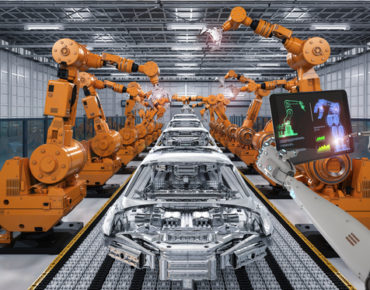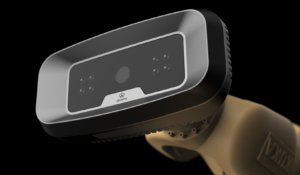Robotic Vision Startup Akasha Imaging Aims to Improve Industrial Manufacturing With AI

With $10.75 million in Series A funding arriving earlier this month, AI robotic vision startup Akasha Imaging is now bulking up its team to ready itself to deliver its nascent AI vision technology to industrial manufacturers by mid-2021.
Founded in 2019, Akasha Imaging is developing its Akasha ClearSight Deep Imaging System, which the company says can be used in any kind of factory lighting conditions and with any materials, including glass and clear plastic, to give dramatically improved vision to robotic manufacturing tools.
Existing AI robotic vision products have difficulties working with glass and clear plastics because light reflects off their surfaces rather than helping the AI vision system to "see" what it is working on, Kartik Venkataraman, the company's CEO, told EnterpriseAI.
What Akasha is trying to solve for manufacturers, he said, is enabling the automation of assembling parts, including very small components and fasteners. "If you look at all the robots that are in the industrial manufacturing space, about 85% of them are used today without any vision systems attached to them," said Venkataraman.
Instead of incorporating advanced AI vision capabilities, existing robotics manufacturing tools are built using fixtures that repetitively guide their movement and actions so they can pick up parts, weld parts and perform other functions as needed on factory floors, he said. "The environment around them is structured precisely for the robots to function."
That's where Akasha is hoping to use its proprietary AI vision technology to revolutionize industrial manufacturing, said Venkataraman.
"The reason [such products are not yet in the marketplace] is not because robotic AI vision is not needed," he said. "It is because the existing technology finds it really difficult to address the problems of getting the accuracy and reliability and the robustness that's needed in identifying the spatial location and orientation of these parts."
The required precision is what makes things more complicated, he said. “Imagine having to take a small screw that is just barely a few millimeters long and turning it into a shaft that's no more than maybe a millimeter or two wide. The precision needed to do that is actually sub-millimeter-level precision.”
The Effects of Component Materials on Robotic Vision
Existing robotic vision systems today only work with opaque materials, such as metals, where light reflects back in predictable ways, said Venkataraman.
“For example, if I gave you a part that is made out of glass and asked you to scan it, there is no existing vision system that would be able to do that,” he said. “That's the precision issue, because existing vision systems rely on light reflecting off the surface, not transmitting through the surface like you have in glass.”
Akasha solves those problems by foregoing laser scanners and projected light systems and instead using different modalities of light with various filters and physical points of view, said Venkataraman. “And by combining different modalities of light with different spectra and different viewpoints we are able to achieve the precision, even for these difficult to handle optically-challenging materials.”
Akasha’s technology can also handle shiny metal, which has the same problem as glass due to its high reflectivity, he said.
The ClearSight Deep Imaging System is still in development but has been successfully used in some validation trials in factories run by a large $50 billion tier one manufacturer, according to Venkataraman. “We have shown that our system works in their environment and their lighting conditions.”
Such AI vision systems could be used by automotive manufacturers and others where shiny metal is used, he said. “You also have in a lot of consumer manufacturing you'll have parts that are made out of clear plastic or glass. Think about the perfume industry. They have the same problems.”
Some commercial contracts have been signed for the technology, he said, but no manufacturers are yet using it in production.
“We are working with our customers to deploy them in factories and we have a timeline to do that in another six to eight months,” by the middle of 2021, Venkataraman said.
“That's the reason we raised the $10.75 million, to be able to scale the team to be able to deliver the product,” he added. “We are enabling a class of operations that up to now has not been automated and that is our strategy.”
Interestingly, it’s become even more important to manufacturers to find these kinds of improved robotics capabilities due to the COVID-19 pandemic, especially when it comes to assembling products, he said.
“If you think about assembly, it has largely been a lot of people working in proximity to each other, assembling a complex product,” he said. “That kind of proximity doesn't work anymore. People need to have distance, which means you have to do more with less. And that's where having robots assisting and enabling the automation of this assembly enables worker safety, and enables production quality to be high, in spite of these frustrations.”
Those heightened needs, brought on by the pandemic, are what have allowed Akasha Imaging to close commercial contracts in the last six months for their AI vision technology “This has now become of strategic importance to companies,” he said.
“When we were in the middle of successful factory validations in February [and March], when the [COVID-19] lockdowns went into effect, we thought at that point that things would not be moving at all for a while,” said Venkataraman. “But, instead, we found that the whole thing accelerated, and we found that managers at the companies we were speaking to were realizing that pandemics may last a long time and may happen again. So, they're putting a lot of effort into automation.”
Akasha’s latest $10.75 million funding round was led by Khosla Ventures, with Sierra Ventures and Promus Ventures participating.
Karl Freund, a senior analyst for HPC and machine learning with Moor Insights & Strategy, told EnterpriseAI that image processing is shifting to manufacturing and robotics today, with improved accuracy, reliability, form factors, and costs.
“3D imaging will transition from fringe to mainstream use cases as these products get to market,” said Freund. “Certainly, Akasha’s ability to secure funding from smart guys like Vinod Khosla says a great deal about their technology,” he added.
Akasha Technology Developed at MIT Media Lab
The core technologies at Akasha Imaging were developed at MIT Media Lab a few years ago by fellow company co-founders Achuta Kadambi and Romesh Raskar, said Venkataraman. In 2019, the co-founders connected with a customer who communicated their problems with AI vision, which inspired the continuing development of the company’s technology. The ClearSight Deep Imaging System took about a year to develop and productize in its current form.
Kadambi, who is also the company’s chief scientist, is an assistant professor at UCLA and was named to the 2019 Forbes 30 Under 30 in Science list. Founding scientist Raskar is an MIT professor and serial entrepreneur who previously worked at Google X and Facebook. Venkataraman previously was the CTO and founder of Pelican Imaging and holds more than 100 imaging patents.
The experience and background of the three co-founders in computational imaging and deep learning led to the development of the Akasha ClearSight Deep Imaging System, which produces extreme 3D images in unstructured environments. The addition of Akasha’s technology can give manufacturers up to a 10x improvement in robotic vision on assembly lines by enabling robots to handle a variety of items with extreme accuracy, irrespective of size, material or illumination condition, according to the company.












